In Wyoming, there are 2 types of venomous snakes. Both of these are species of rattlesnakes. In this article, we will describe each of these snakes. We’ll also tell you where they live in Wyoming.
There’s also a section below on pit vipers since rattlesnakes are pit vipers. We’ve also added a section on rattlesnakes in general.
- Prairie Rattlesnake(Crotalus viridis viridis)
- Midget Faded Rattlesnake(Crotalus Oreganus Concolor)
- Northern Pacific Rattlesnake(Crotalus oreganus)
Pit Vipers
Pit Vipers in the United States are Rattlesnakes, Copperheads, and Cottonmouths. They all belong to the venomous Crotalinae or pit viper family. Pit vipers have a facial pit between their nostril and eyes on each side of their face. These pits are actually specialized organs that detect body heat from warm-blooded prey. Pit organs enable pit vipers to strike their prey precisely, even in the dark. They are also able to detect body heat from about 1 meter away. See
These snakes also have a triangular head attached to a slender neck. Furthermore, the pupils of their eyes are vertical slits.
Pit vipers have hollow fangs connected to venom glands on each side of the roofs of their mouths. They use their fangs to inject venom into their prey. This venom immobilizes the prey, making it easier for the snake to consume. All pit vipers are born with multiple fangs and replace them every couple of months. Old fangs are shed one at a time. Consequently, a pit viper bite may only involve one fang.
Interestingly, these snakes have a sphincter on each venom gland. This allows them to control the amount of venom going through the fangs. A snake may elect not to inject any venom with a bite. Scientists surmise that this is because it takes time to rebuild its venom store. Twenty to twenty-five percent of pit viper-to-human bites are dry bites. In other words, they are venomless. Source
Pit viper food sources include small mammals, reptiles, amphibians, small birds, and insects. These snakes play an important role in maintaining balance in rodent populations.
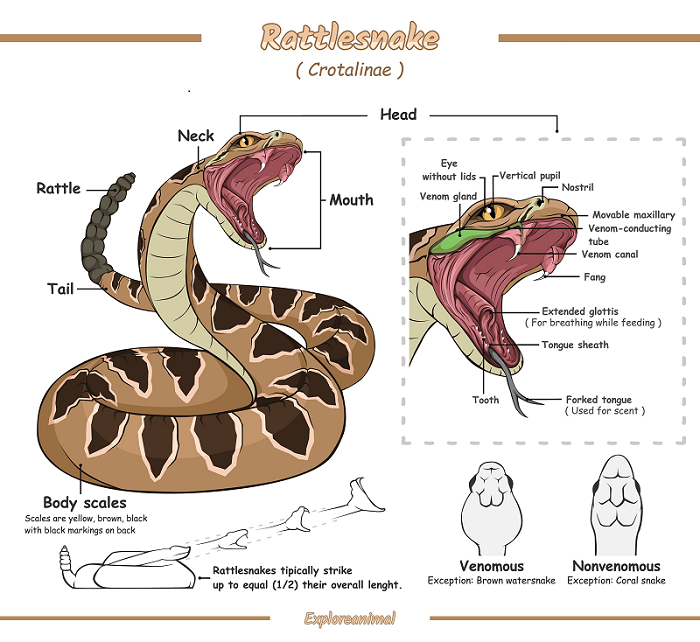
Rattlesnakes
The first thing people think about with regard to rattlesnakes is their tails. When they are disturbed, they vibrate their rattles using their tail muscles. This makes a buzzing or rattling-type sound. The specific purpose of the rattle is to warn larger animals to stay away. Sometimes, rattlers strike without rattling, though. Sometimes, their rattles fall off.
You must be aware of where you place your hands and feet in rattlesnake country. If you hear a rattling noise, do not move until you spot where it’s coming from. Otherwise, you may accidentally move into the snake, provoking it to strike you. You should carefully move to a safe distance when you’ve located the snake. But carefully scan your surroundings because the snake you see might not be the only one around.
When moving through a known rattlesnake area, you should have your dog on a leash. If you have hunting dogs, they should be wearing snake armor.
It’s a good idea to carry a long stick. You can use it to tap the ground in front of you to warn any snakes of your approach. You can also use the stick to part any dense vegetation or tall grass in your path.
If you are hiking in rattlesnake country, it would be a good idea to wear snake boots or snake gaiters. This protects your lower legs from being bitten by a snake.
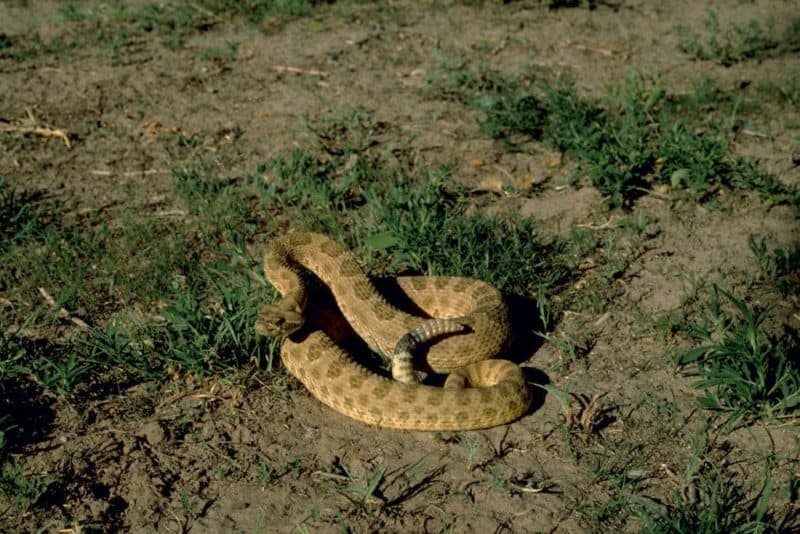
Prairie Rattlesnake
| Scientific Name: | Crotalus viridis |
| Description: | Adult Prairie Rattlesnakes average 3.3 feet (100 cm) in length. They are tan-colored with varying colors of brown blotches covering their bodies. |
| Habitat: | Look for Prairie rattlesnakes in open prairies, grasslands, and forested areas. |
| Conservation Status: | Protected Species in Wyoming |
The Prairie Rattlesnakes’ average length is 3ft to 5ft (.91 to 1.5 M) long. Their background coloration is tan-toned. Over this, they have 33 to 55 dark brown blotches covering their bodies. Towards their tails, the blotches change into rings. They have a distinguishing triangle-shaped head with pit sensory organs on either side. A light stripe runs diagonally from the back of the eye to the jaw. Another strip runs diagonally from below the eye to the corner of the mouth.
Prairie Rattlesnakes are ambush predators. This means they will sit and wait until their prey comes by before striking. They use their pit organs and tongues to sense their prey.
All snakes, including prairie rattlesnakes, flick their tongues to smell the air. They are able to pick up tiny chemical particles that help them zero in on their prey. See
Prairie rattlesnakes are mostly ground snakes. But they occasionally climb into shrubs, bushes, or trees.
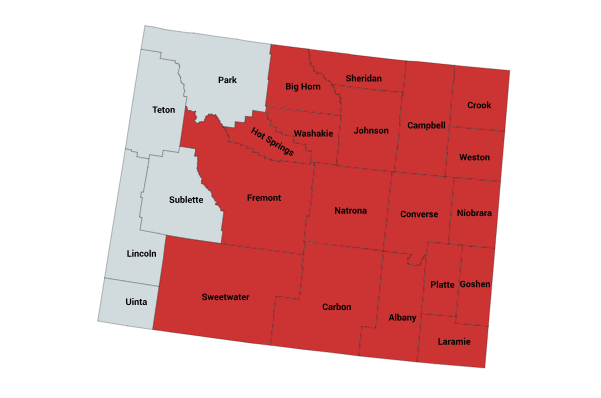
Where Do Prairie Rattlesnakes Live in Wyoming?
Prairie Rattlesnakes live in every Wyoming county east of the Continental Divide. They also inhabit Carbon County, which is west of the Continental Divide. They primarily live in open prairie habitat. However, in some parts of their range, their territory extends into mountainous areas. They live up to 9500 ft. above sea level. See
Watch out for them around rocky ledges where they seek shade or sun themselves. Also, look for them in close proximity to prairie dog towns.
Prairie Rattlesnake Behavior
In Wyoming, prairie rattlesnake season is mainly from April to October. They spend the colder months brumating in underground dens.
Bumation is a reptile’s version of hibernation. Prairie Rattlesnakes brumate in communal dens. But their hunting grounds extend as far as seven miles from their dens in the summertime. In the warmer months, prairie rattlers might shelter in old mammal burrows. But in the fall, they will return to their communal dens.
Prairie Rattlesnake dens are generally located on south-facing slopes. Southerly slopes receive more direct sunlight. Abandoned animal burrows and rock crevices make likely denning sites.
These snakes mate in the late spring and early summer. Male Prairie Rattlesnakes participate in combat rituals. They do this for the right to mate with receptive females. When they do this, they face each other with their heads and part of their bodies elevated off the ground. They then intertwine and attempt to knock each other to the ground. The snake that doesn’t get knocked to the ground wins breeding privileges. See
Pregnant female Prairie Rattlesnakes give birth to 8 to 17 babies in late summer. Like the majority of pit vipers, rattlesnakes are viviparous. This means that they give live birth rather than laying eggs.
Baby Prairie Rattlesnakes are born fully equipped to take care of themselves. They are on their own after a few days.
What Do Prairie Rattlers Eat?
A Prairie rattlesnake’s favorite food is small mammals. Accordingly, mice, rats, rabbits, ground squirrels, and prairie dogs are on their menu. They will also eat ground-nesting birds and occasionally small amphibians and reptiles.
How Dangerous Are Prairie Rattlesnakes?
Prairie rattler venom is a mix of hemotoxins and mycotoxins. Furthermore, according to some literature, it also has neurotoxins.
Prairie rattlesnake bites can have serious effects. The venom can cause severe pain. It may also induce shock, making the victim feel weak and disoriented. Swelling, blistering, and inflammation can occur at the bite site. Their hemotoxic venom can also damage red blood cells and impair blood clotting. On the other hand, myotoxic venom contains digestive enzymes that destroy body tissue. In severe cases, the bite may result in severe tissue damage. There is also a risk of harm to internal organs. Source
Sheridan lies within Wyoming’s Prairie Rattlesnake country. Lynn Grady is the Emergency Department Manager at Sheridan Memorial Hospital. She states that, on average, they receive one rattlesnake bite victim needing anti-venom each year. Source
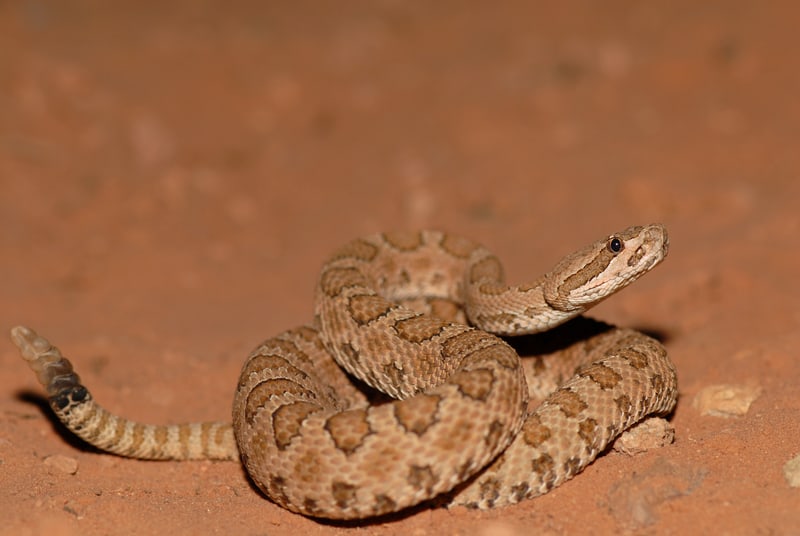
Midget-faded Rattlesnake
| Scientific Name: | Crotalus o. concolor |
| Description: | 20 to 30 inches (508 to 762mm) long. Cream, brownish-grey, or a straw-like color. |
| Habitat: | Rocky terrain |
| Conservation Status: | Extremely rare |
Midget Faded rattlesnakes are cream, brownish-grey, or a straw-like color. This species is a subspecies of the western rattlesnake. Adults grow from 20 to 30 inches (508 to 762mm) in body length. Males are usually longer and heavier than females.
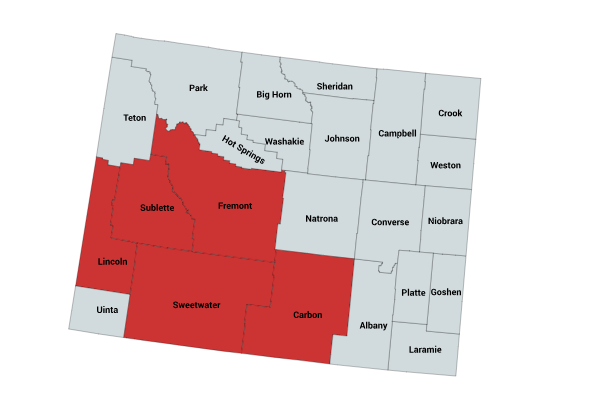
Where Do Midget Faded Rattlesnake Live in Wyoming?
Midget Faded Rattlesnakes live in southwestern Wyoming. More specifically, they inhabit the rocky terrain of the Green River drainage. They prefer the rocky terrain of the canyons and plateaus.
What Do Midget Faded Rattlesnakes Eat?
Midget Faded Rattlesnakes primarily eat reptiles such as lizards and small snakes. According to the Wyoming Game and Fish Department, this is why they have neurotoxic venom. Venomous snakes that feed on reptiles tend to have neurotoxic venom. On the other hand, Venomous snakes that feed on warm-blooded prey tend to have hemotoxic venom. Source
How Dangerous Are Midget-Faded Rattlesnakes?
Midget Faded rattlesnake venom has strong neurotoxic properties. In fact, they have more potent venom than that of some cobras. A bite from one of these dangerous snakes interferes with nerve impulses. Symptoms of neurotoxic envenomation include droopy eyelids, frothy saliva, and slurred speech. More serious effects include paralysis of the skeletal muscles and respiratory failure. Source Source
Symptoms of Rattlesnake Bites
Some of the symptoms you may experience from a venomous snake bite include:
- Discoloration in the area of the bite.
- Swelling in the area of the bite.
- Loss of muscle coordination.
- Tingling sensation in the area of the bite.
- Feeling nauseous.
- Having an abnormally rapid pulse.
What Should You Do If A Venomous Snake Bites You?
If you or someone you are with has suffered a venomous snakebite, time is of the essence. This is because the sooner a victim receives anti-venom, the less likely the venom in their body is to cause harm. In other words, it is important to seek immediate medical treatment.
Do not attempt to kill the snake for identification purposes. This gives the snake a chance to bite you again. Also, consider that severed snakeheads can still bite and envenomate. If you have a phone, the best thing you can do is take a picture of the offending reptile. Otherwise, get started on your way to the emergency room.
First Aid for Snake Bite Victims
- Remain calm and limit your movements. Do not run. If you must hike back to a vehicle, do it calmly and deliberately. Put as little stress on your heart as possible.
- Keep the area of the snake bite below the heart level and never above the heart level. Keeping the bite below the heart level will reduce the venom’s flow. However, holding the bite above your heart level will increase the venom’s flow.
- Remove all constricting items such as bracelets, watches, or rings before swelling occurs.
- Remember that using a cold compress on a venomous snake bite is not advisable. The cold may cause the local blood vessels to constrict and spread the venom faster.
- You can wash the affected area like any other wound with soap and water.
- You may cover the bite area with a moist dressing to reduce the swelling.
- Get medical help as soon as possible. Call the hospital to tell them a venomous snake has bitten you. So they can have anti-venom ready to give you when you arrive.
- A person whom a venomous snake has bitten may go into shock. If this happens, lay them flat and cover them with a blanket.
Dressing for Snake Country
- High-top leather boots and long pants are both a good idea.
- Also, wear loose-fitting denim. If there’s a gap before the snake’s fangs touch your skin, your chances of being envenomated are lower.
- In the absence of high-top leather boots, some people wear snake gaiters.
Rattlesnake Predators
Rattlesnake Predators That Are Immune to Rattlesnake Venom
Although they are venomous, Prairie Rattlesnakes do have some potential predators.
- One of these is the North American Racer. These snakes are immune to snake venom. They pin down their prey with their body and swallow it alive. Consequently, they are probably limited to very small rattlesnakes. North American Racers have been recorded eating rattlesnakes in the Black Hills. Source
- The non-venomous Western Milksnake’s coloration imitates that of venomous coral snakes. Western Milksnakes kill by constriction. They are immune to snake venom. Consequently, they sometimes prey on South Dakota’s Prairie Rattlesnakes.
- Skunks also prey on rattlesnakes. Fortunately for them, they are also immune to snake venom.
- Badgers also eat rattlesnakes and have some immunity to rattlesnake venom. In some states like South Dakota, badgers are the top predators of rattlesnakes.
- Feral hogs are also immune to snake venom and find rattlesnakes to be tasty snacks.
Rattlesnake Predators That Are Not Immune to Rattlesnake Venom
The following animals occasionally prey on rattlesnakes. But they are not immune to their venom. They have to manage to kill the snake without being bitten.
- coyotes
- bobcats
- mountain lions
- raptors
Rattlesnake Lookalikes in Wyoming

Bull Snakes
Bull Snakes are large, non-venomous snakes. In fact, the Bull Snake is the largest snake in Wyoming. Individual snakes are capable of being 8 feet (2.43 M) long. People often mistake bull snakes, which are also called gopher snakes, for rattlesnakes. This is primarily because they are similarly marked. Bull snakes can do a pretty fair rattlesnake impression when they’re agitated. They do this by coiling in a defensive posture and flattening their heads. They even vibrate their tails sometimes. The best way to differentiate between a bull snake and a rattlesnake is to observe the tail. Bull snakes don’t have a rattlesnake’s rattle. Instead, their tail comes to a fine point.

Plains Hog-Nosed Snake
Wyoming is also home to the Plains Hog-nosed snake. The Plains Hog-nosed snake is a rear-fanged colubrid snake and is mildly venomous. However, they are not dangerous to humans.
Plains Hog-nosed snakes are also called Western hog-nosed snakes or blow snakes. They are relatively short and stout-bodied. Their color pattern is variable. But most morphs of this snake resemble a rattlesnake in coloration.
When threatened, these snakes flatten their heads, hiss, and vibrate tails like rattlesnakes. They also may bluff strike without opening their mouths. This is more like a headbutt than a strike. As a last resort defense mechanism, they play dead.
Recent Posts
The only venomous snakes in Washington State are Northern Pacific Rattlesnakes. The Northern Pacific Rattlesnake (Crotalus oreganus oreganus) is a sub-species of the Western Rattlesnake. Anyone...
Skunks are not classified as true hibernators. But they go into a state of torpor when the weather gets cold. Skunks are light sleep hibernators, along with opossums, bears, and raccoons. ...

